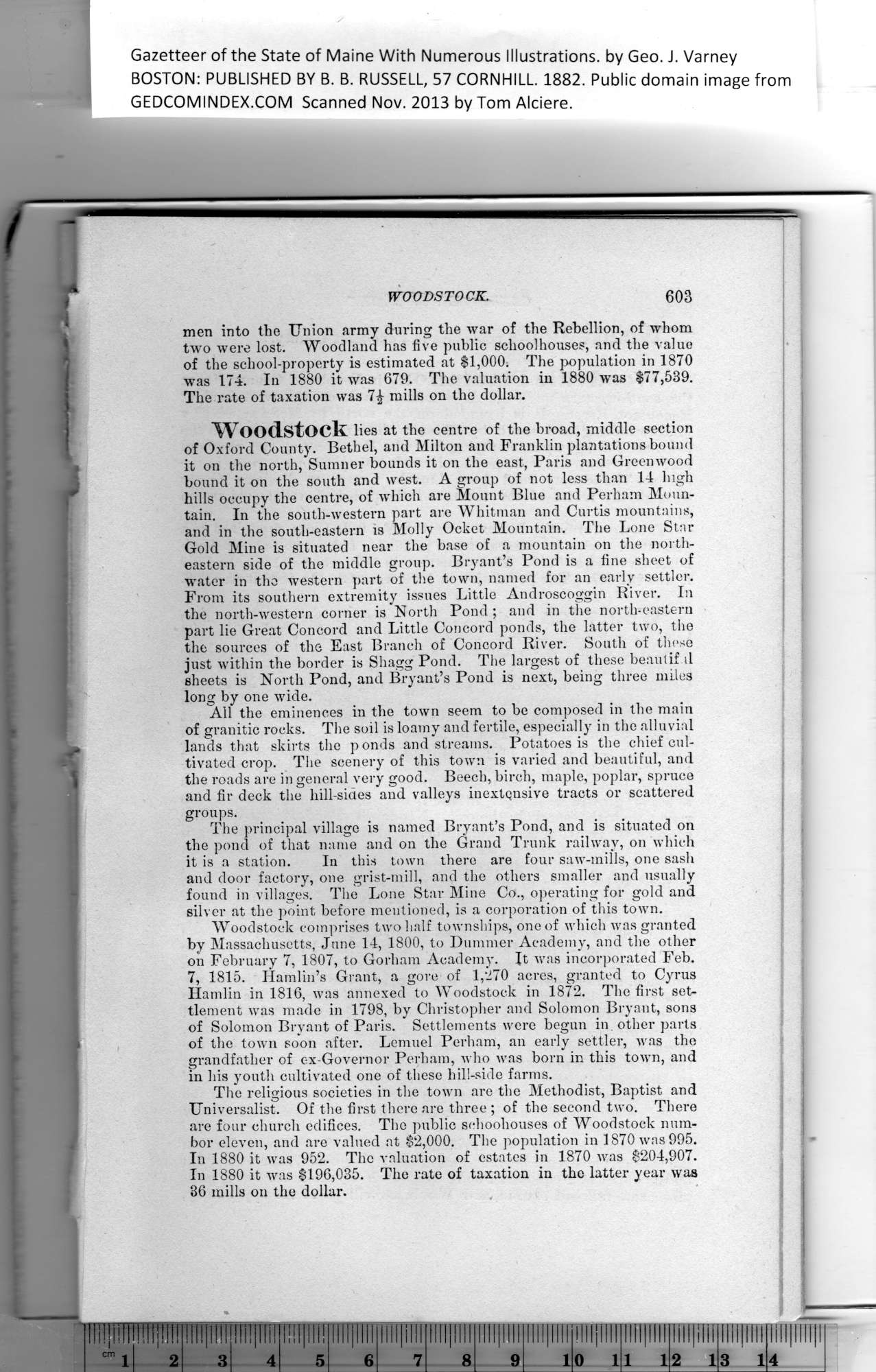|
Gazetteer of the State of Maine With Numerous Illustrations, by Geo. J. Varney
BOSTON: PUBLISHED BY B. B. RUSSELL, 57 CORNHILL. 1882. Public domain image from
WOODSTOCK. 603
men into the Union army during the war of the Rebellion, of whom
two were lost. Woodland has five public schoolhouses, and the value
of the school-property is estimated at $1,000. The population in 1870
was 174. In 1880 it was 679. The valuation in 1880 was $77,539.
The rate of taxation was 7£ mills on the dollar.
Woodstock lies at the centre of the broad, middle section
of Oxford County. Bethel, and Milton and Franklin plantations bound
it on the north, Sumner bounds it on the east, Paris and Greenwood
bound it on the south and west. A group of not less than 14 high
hills occupy the centre, of which are Mount Blue and Perham Moun-
tain. In the south-western part are Whitman and Curtis mountains,
and in the south-eastern is Molly Ocket Mountain. The Lone Star
Gold Mine is situated near the base of a mountain on the north-
eastern side of the middle group. Bryant’s Pond is a fine sheet of
water in the western part of the town, named for an early settler.
From its southern extremity issues Little Androscoggin River. In
the north-western corner is’North Pond; and in the north-eastern
part lie Great Concord and Little Concord ponds, the latter two, the
the sources of the East Branch of Concord River. South of these
just within the border is Shagg Pond. The largest of these beautiful
sheets is North Pond, and Bryant’s Pond is next, being three miles
long by one wide.
All the eminences in the town seem to be composed in tbe main
of granitic rocks. The soil is loamy and fertile, especially in the alluvial
lands that skirts the ponds and streams. Potatoes is the chief cul-
tivated crop. The scenery of this town is varied and beautiful, and
the roads are in general very good. Beech, birch, maple, poplar, spruce
and fir deck the hill-sides and valleys inextqnsive tracts or scattered
groups.
The principal village is named Bryant’s Pond, and is situated on
the pond of that name and on the Grand Trunk railway, on which
it is a station. In this town there are four saw-mills, one sash
and door factory, one grist-mill, and the others smaller and usually
found in villages. The Lone Star Mine Co., operating for gold and
silver at the point before mentioned, is a corporation of this town.
Woodstock comprises two half townships, one of which was granted
by Massachusetts, June 14, 1800, to Dummer Academy, and tbe other
on February 7, 1807, to Gorham Academy. It was incorporated Feb.
7, 1815. Hamlin’s Grant, a gore of 1,270 acres, granted to Cyrus
Hamlin in 1816, was annexed to Woodstock in 1872. The first set-
tlement was made in 1798, by Christopher and Solomon Bryant, sons
of Solomon Bryant of Paris. Settlements were begun in. other parts
of the town soon after. Lemuel Perham, an early settler, tvas the
grandfather of ex-Governor Perham, who was born in this town, and
in his youth cultivated one of these hill-side farms.
The religious societies in the town are the Methodist, Baptist and
Universalist. Of the first there are three ; of the second two. There
are four church edifices. The public schoobouses of Woodstock nurn-
bor eleven, and are valued at $2,000. The population in 1870 was 995.
In 1880 it was 952. The valuation of estates in 1870 was $204,907.
In 1880 it was $196,035. The rate of taxation in the latter year was
36 mills on the dollar.
PREVIOUS PAGE ... NEXT PAGE
This page was written in HTML using a program written in Python 3.2
|
